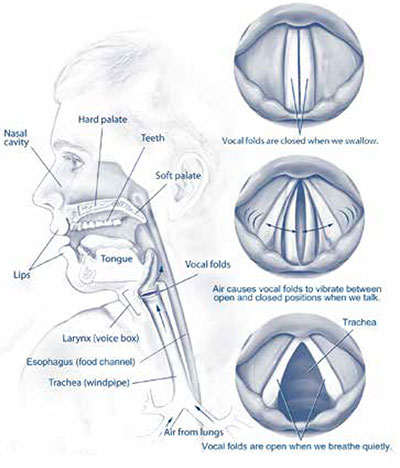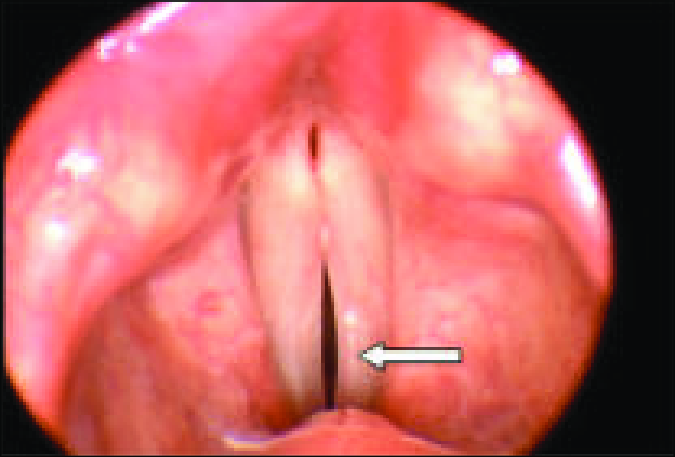Joseph R. Anticaglia, MD
Medical Advisory Board
One of the things we take for granted is a good voice, one that is strong, easily understood and of good quality. We have a problem when a voice disorder interferes with our ability to communicate with family and friends, or to earn a living.
As we get older, our voice can change. People, in their sixties or older, can experience changes in the voice box (larynx), or vocal tract (see below) that can affect the loudness, pitch and the overall quality of sound.
Larynx
The voice box (larynx) is made of muscle, mucosa, and cartilage. It is located behind the Adam’s Apple. The vocal folds, or vocal cords contain muscle and mucosa. The vocal folds vibrate when air pressure generated by the lungs moves upward through the windpipe (trachea) to the undersurface of the vocal folds.
The air pressure from the lungs, as noted, causes the vocal folds to vibrate which results in a buzzing sound, not speech. The air pressure and sound waves continue above the vocal folds along the vocal tract which includes the throat, mouth, and nasal cavity. The vocal track shapes the buzzing sounds into speech sounds which eventually becomes recognizable words.(see diagram below).

Symptoms
The elderly patients may have complaints about their:
- Voice quality: The voice may sound hoarse — rough, breathy, raspy, or strained.
- Pitch changes: Men notice they’re speaking in a higher pitch; women in a lower pitch.
- Voice weakness (Presbyphonia): The voice may become softer and less powerful. One may experience difficulty projecting the voice.
- Vocal fatigue: The voice tires more quickly. After prolonged speaking, the voice may feel tired, or strained. It may become an effort to talk.
- Loss of vocal range: Difficulty reaching the high or low notes.
- Throat Clearing: Repeatedly clearing your throat.
- Tremor: Shakiness of the voice.
Causes of the Aging Voice
Two fundamental factors contribute to voice changes in the aging voice. One involves the vocal folds of the larynx which make the initial buzzing, voice sound; the other factor involves the lungs which generate air pressure that powers the voice.
Presbylaryngis (Presbyphonia)
As one gets older, the sound of the voice may become weak and abnormal because:
- the muscle mass of the vocal folds shrinks-atrophies, and/or
- the mucosa of the vocal folds may become thinner, lose elasticity, and/or
- the cartilage of the voice box may stiffen, which adversely affecting the sound, and the normal functioning of the vocal folds.
Lungs
Age-related medical conditions can affect vocal function. For example, emphysema, chronic obstructive pulmonary disease, COPD, or asthma may decrease the projection, strength, smoothness and fluency of a person’s voice.

It’s necessary to rule out other causes of voice changes in the elderly. Several conditions that can affect the voice include vocal fold nodules, polyps, vocal fold cancer, vocal fold paralysis, and neurological disorders. A thorough evaluation by a physician such as an otolaryngologist (ear, nose, and throat specialist) is necessary to determine the exact cause.
Psychological Effects
The changes in the aging voice may impact self-esteem, confidence, and social interactions. Some individuals may experience frustration, embarrassment, isolation, or a sense of loss due to changes in their voice. People have found psychological counselling useful in these circumstances.
Treatment
The aging voice alone is not a common occurrence. Treatment depends on making an accurate diagnosis of this condition after excluding other problems like vocal nodules or vocal polyps.
Speech therapy offered by speech-languages pathologists, can provide vocal exercises and techniques to improve vocal function, breath control and the quality of your voice. Medical treatment of menopausal women experiencing voice changes due to hormonal fluctuations may benefit with estrogen replacement treatment.
Phonosurgery is any procedure designed to improve or restore voice quality. Such surgery uses an operating microscope with micro-instrumentation to evaluate and manage any pathology that involves the vocal folds and larynx.
Vocal Cord Injection is a surgical procedure in which a filling agent is injected into the area of the vocal fold that lacks bulk as in vocal fold bowing, or lack of movement as in vocal fold paralysis.
Prevention Use Your Voice
Whether we’re young or old, lack of proper exercise will eventually lead to muscle atrophy. As we get older, muscle atrophy can happen insidiously in the larynx as well. If you’re older, you might talk less because you live alone, are depressed or you’re not socially engaged.
Consider exercising the laryngeal muscles daily by becoming more active socially, reading out loud at home, and as strange as it may seem to some, by singing your favorite songs. Also, stay hydrated, eat nutritiously, avoid smoking, and have regular check-ups with your doctor to stay healthy.
Most often elderly people don’t experience voice changes solely due to aging. If you’re concerned about changes in your voice that last more than several weeks, it’s best to have your larynx examined by a specialist to determine the diagnosis and the best treatment
Glossary
Presbylaryngis happens when the muscles in the vocal folds atrophy (shrink) and curve inward causing a bowing of the larynx seen in the elderly and aging voice.
Presbyphonia is a condition that happens when changes in the larynx cause poor vocal quality, such as reduced vocal stamina, difficulty projecting one’s voice, or reduced volume.
Dysphonia — change in the quality of the voice when trying to talk, for instance hoarseness.
References
- Joseph R. Anticaglia, MD; The Human Voice: What It Is and How It Works; Doctors Column, HC Smart, July 23, 2016
- Amanda Cibelly Brito Gois et al; Factors associated with voice disorders among the elderly: a systematic review; Braz. J. Otorhinolaryngology, July-August 2018
- P Woo 1, J Casper, R Colton, D Brewer; Dysphonia in the aging: physiology versus disease; Laryngoscope, Feb 1992
- Sataloff, Robert Thayer; The Human Voice; Scientific America, December 1992
- NIH; Taking Care of Your Voice; April 15, 2021
This article is intended solely as a learning experience. Please consult your physician for diagnostic and treatment options.

